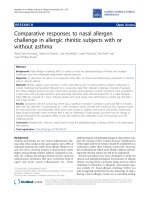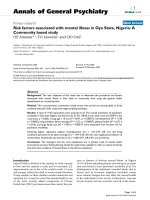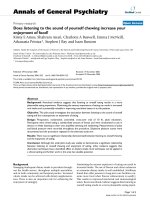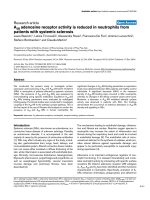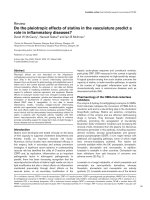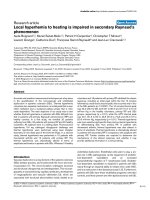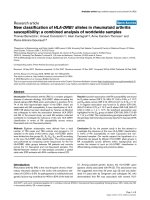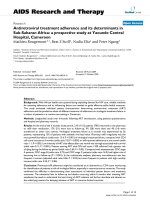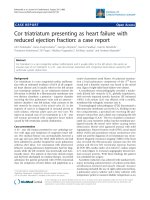Báo cáo y học: "Prophylactic anticoagulation to prevent venous thromboembolism in traumatic intracranial hemorrhage: a decision analysis" ppt
Bạn đang xem bản rút gọn của tài liệu. Xem và tải ngay bản đầy đủ của tài liệu tại đây (968.8 KB, 10 trang )
Scales et al. Critical Care 2010, 14:R72
/>Open Access
RESEARCH
BioMed Central
© 2010 Scales et al.; licensee BioMed Central Ltd. This is an open access article distributed under the terms of the Creative Commons
Attribution License ( which permits unrestricted use, distribution, and reproduction in
any medium, provided the original work is properly cited.
Research
Prophylactic anticoagulation to prevent venous
thromboembolism in traumatic intracranial
hemorrhage: a decision analysis
Damon C Scales*
1,2,3
, Jay Riva-Cambrin
4,5
, Dave Wells
1
, Valerie Athaide
6
, John T Granton
1,7
and Allan S Detsky
8,9
Abstract
Introduction: Patients with intracranial hemorrhage due to traumatic brain injury are at high risk of developing
venous thromboembolism including deep vein thrombosis (DVT) and pulmonary embolism (PE). Thus, there is a trade-
off between the risks of progression of intracranial hemorrhage (ICH) versus reduction of DVT/PE with the use of
prophylactic anticoagulation. Using decision analysis modeling techniques, we developed a model for examining this
trade-off for trauma patients with documented ICH.
Methods: The decision node involved the choice to administer or to withhold low molecular weight heparin (LMWH)
anticoagulation prophylaxis at 24 hours. Advantages of withholding therapy were decreased risk of ICH progression
(death, disabling neurologic deficit, non-disabling neurologic deficit), and decreased risk of systemic bleeding
complications (death, massive bleed). The associated disadvantage was greater risk of developing DVT/PE or death.
Probabilities for each outcome were derived from natural history studies and randomized controlled trials when
available. Utilities were obtained from accepted databases and previous studies.
Results: The expected value associated with withholding anticoagulation prophylaxis was similar (0.90) to that
associated with the LMWH strategy (0.89). Only two threshold values were encountered in one-way sensitivity analyses.
If the effectiveness of LMWH at preventing DVT exceeded 80% (range from literature 33% to 82%) our model favoured
this therapy. Similarly, our model favoured use of LMWH if this therapy increased the risk of ICH progression by no more
than 5% above the baseline risk.
Conclusions: Our model showed no clear advantage to providing or withholding anticoagulant prophylaxis for DVT/
PE prevention at 24 hours after traumatic brain injury associated with ICH. Therefore randomized controlled trials are
justifiable and needed to guide clinicians.
Introduction
It is estimated that more than 1.5 million people in the
United States sustain traumatic head injury each year [1].
Radiologic evidence of intracranial hemorrhage at the
time of presentation is present in up to 45% of cases and
is associated with a markedly poorer prognosis [2,3].
Traumatic intracranial hemorrhage encompasses cerebral
contusion, subdural hematoma, subarachnoid hemor-
rhage, epidural hematoma and intracerebral hemorrhage.
These are characterized by a relatively high risk of bleed-
ing progression, especially within the first 24 hours [2,4-
6].
Traumatic intracranial hemorrhage is also associated
with a high risk of thromboembolic complications [7].
This risk is related to the immobility of head-injured
patients arising from the underlying neurologic lesion
itself, concomitant injuries following trauma, or the use
of sedatives and neuromuscular blocking agents. The
reported incidence of deep vein thrombosis (DVT)
ranges between 18 and 58% in the absence of anticoagu-
lant prophylaxis [8-11]. DVT is associated with increased
morbidity and mortality, including risk of fatal pulmo-
nary embolism (PE) [12].
* Correspondence:
1
Department of Critical Care Medicine, Sunnybrook Health Sciences Centre,
2075 Bayview Avenue, Room D108, Toronto, ON M4N 3M5, Canada
Full list of author information is available at the end of the article
Scales et al. Critical Care 2010, 14:R72
/>Page 2 of 10
Anticoagulant prophylaxis to prevent DVT is recom-
mended for trauma patients without intracranial or other
serious hemorrhage [13]. This therapy is also effective in
post-operative neurosurgical patients undergoing brain
tumour excision [12]. Only one small quasi-randomized
clinical trial has studied anticoagulant prophylaxis versus
pneumatic compression devices in patients with intracra-
nial hemorrhage following trauma. This trial found no
benefit or harm associated with use of anticoagulant pro-
phylaxis, but only had sufficient sample size to detect
very large differences in rates of venous thromboembo-
lism or intracranial hemorrhagic progression [14]. One
observational study reported rates of hemorrhagic pro-
gression in 150 patients with intracranial hemorrhage
that were treated with low molecular weight heparin pro-
phylaxis 24 hours after the initial head injury [15]. One
quarter already had radiological evidence of intracranial
hemorrhagic progression at the time anticoagulant pro-
phylaxis was started, but only six patients (4%) subse-
quently developed progression in the 24 hours following
initiation of anticoagulation prophylaxis. The study
lacked a control group limiting inferences regarding the
safety and efficacy of this therapy.
Many physicians report routinely withholding antico-
agulation prophylaxis in patients with traumatic intracra-
nial hemorrhage because of concerns that it may increase
the risk of potentially devastating intracranial hemor-
rhagic progression [16,17]. Observational studies have
also documented variable practice patterns for anticoagu-
lation prophylaxis in such patients. A small retrospective
study of 88 patients with traumatic brain injury observed
that only 42% ever received low-molecular weight hepa-
rin prophylaxis, and the mean time to initiation of ther-
apy was 14 days [18]. Similarly, a multicentre
retrospective study of trauma patients with ICU length of
stay greater than seven days found that prophylaxis was
initiated within two days in only 25% of patients, and
another quarter did not receive prophylaxis until at least
one week following injury [19]. Thus, the use and timing
of anticoagulation prophylaxis in these patients remains
uncertain and controversial, and most are treated with
more conservative and less effective measures such as
graduated compression stockings, intermittent pneu-
matic compression devices, and physiotherapy [13,16].
The lack of persuasive evidence to guide decisions
about using anticoagulant prophylaxis in patients with
traumatic intracranial hemorrhage implies that clinicians
must make decisions based on their own assessments of
the risks and benefits. Our objective was to explore the
decision to use or withhold anticoagulant prophylaxis in
a common clinical scenario characterized by competing
risks of hemorrhagic versus thromboembolic complica-
tions. We used decision analysis modeling techniques to
compare the risks of progression of intracranial hemor-
rhage following trauma versus the potential benefits of
reducing venous thromboembolism with anticoagulant
prophylaxis. Decision analysis involves identifying the
most important available clinical choices and determin-
ing probabilities of all important potential outcomes fol-
lowing each of these choices [20]. This methodology has
been used previously to evaluate the risks and benefits of
anticoagulant prophylaxis in neurosurgical patients
undergoing craniotomy [21], but to our knowledge has
not specifically been used to evaluate patients with trau-
matic intracranial hemorrhage.
Materials and methods
Probabilities and utilities
We searched Medline (OVID Technologies, New York,
NY, USA; 1950 to March 2008) for studies concerning
intracranial hemorrhage and anticoagulant thrombopro-
phylaxis using the search terms brain injury, acute; cran-
iocerebral trauma; cerebral hemorrhage, traumatic,
anticoagulation, and heparin. We used natural history
studies and controlled clinical trials performed in both
post-operative neurosurgical and trauma patients to esti-
mate the incidence of DVT [9-12,22]. We estimated the
risk of hemorrhagic progression using natural history
studies that reported the absolute risk at 24 hours follow-
ing the neurological injury [15]. The risk of systemic
bleeding complications was estimated from rates of major
gastrointestinal hemorrhage in critically-ill patients [23].
We used clinical trials of anticoagulation prophylaxis in
elective neurosurgical patients to estimate the effective-
ness of anticoagulant prophylaxis in preventing DVT and
its potential impact on subsequent intracranial bleeding
[12,24,25].
Table 1 summarizes the probabilities used in the deci-
sion analysis. We obtained utility values (Table 2) from
previous publications and the Cost-Effectiveness Analysis
Registry from the Institute for Clinical Research and
Health Policy Studies, Tufts Medical Center [26-35]. We
considered the baseline utility for our study (0.96) to be
less than a perfect state of health (1.00) because all
patients in our model would have already suffered a
major trauma with associated head injury [36]. We sub-
tracted utilities associated with temporary states in our
model, such as deep vein thrombosis, from the baseline
utility, but we considered events having long-term mor-
bidity, such as disabling neurological deficit, by multiply-
ing the associated utility by the baseline utility [28]. The
most severe event that could be encountered in the model
was death (utility = 0), and the worst outcome that could
be experienced while alive was a severe disabling neuro-
logical deficit after progression of intracranial hemor-
rhage.
We also performed sensitivity analyses considering
estimates of benefits and risks of anticoagulant prophy-
Scales et al. Critical Care 2010, 14:R72
/>Page 3 of 10
Table 1: Probabilities used in the decision analysis
Variables Baseline probability Range of plausible
probabilities
Threshold value within
published range
Threshold from 0 to 1
Probability of DVT 0.32 [12] 0.18 to 0.50 [[9] to [11,12]] No Yes (> 0.6*)
Probability of PE following
development of DVT
0.1[42,43] 0.01 to 0.18 [22,24,44,45] No Yes (> 0.3*)
Probability of death from PE 0.17 [46] 0 to 0.50 [47] No No
Probability of a CNS bleed on
LMWH
0.108 [15] 0.03 to 0.23 [24,44] No Yes (> 0.017
+
)
Effectiveness of LMWH in
preventing DVT (e)
0.47 [12] 0.33 to 0.82 [12,42] Yes (> 0.8*) Yes (> 0.8*)
Probability of death from a
CNS bleed
0.105 [48] 0.08 to 0.3 [49,50] No No
Probability of disabling
neurological deficit after CNS
bleed
0.17 [51] 0.16 to 0.33 [52,53] No No
Probability of an ICU-related
systemic bleed
0.035 [23] 0.027 to 0.046 [23] No No
Probability of death from
ICU-related systemic bleed
0.02 [23] 0.001 to 0.035 [23,46] No No
Effectiveness of not receiving
LMWH in reducing CNS
bleeds
0.315 [4,15] 0.001-0.99 [4-6,23,47,54] Yes (> 0.05
+
) Yes (> 0.05
+
)
Effectiveness of not receiving
LMWH in reducing ICU-
related systemic bleeds
0.146 0 to 0.66 [8,12,55] No No
Table of probabilities and plausible ranges used for the decision analysis. The last two columns indicate variables for which a threshold value was
identified in one-way sensitivity analysis. Values with an asterisk (*) indicate a threshold value above which providing anticoagulant prophylaxis
becomes the preferred strategy. Values with a plus (+) indicate a threshold value above which withholding anticoagulant prophylaxis becomes
the preferred strategy.
CNS: central nervous system; DVT: deep vein thrombosis; ICU: intensive care unit; PE: pulmonary embolism
Table 2: Utilities used in the decision analysis
Utility Baseline value Published ranges Threshold value
within published
range
Threshold value
reached between
0 and 1
Baseline 0.96 [36] 0.95 to 1.0* No No
LMWH prophylaxis 0.99 [27] 0.9 to 1.0* No No
Living with DVT 0.95 [27] 0.92 to 1.0* No Yes (> 0.9
+
)
Living with PE 0.7 [35] 0.6 to 0.9 [32] No No
Living with massive systemic bleed 0.7 [27] 0.6 to 0.8* No No
Living with a non-disabling ICH 0.75 [33,34] 0.6 to 0.8 [33,34,56,57] No No
Living with a disabling ICH 0.39 [33,34] 0.14 to 0.43 [33,34,57] No No
Table of utilities and plausible ranges used for the decision analysis. Ranges with an asterisk (*) were generated from a consensus of authors.
The last two columns indicate variables for which a threshold value was identified in one-way sensitivity analysis. Values with a plus (+)
indicate a threshold value above which withholding anticoagulant prophylaxis becomes the preferred strategy. DVT: deep vein thrombosis;
ICH: intracranial hemorrhage; LMWH: low molecular weight heparin; PE: pulmonary embolism
Scales et al. Critical Care 2010, 14:R72
/>Page 4 of 10
laxis reported on our recent survey of Canadian neuro-
surgeons and neuro-intensivists [17]. We chose the three
most frequent estimates of risk-category selected by sur-
vey respondents for risk of intracranial hemorrhagic pro-
gression and for risk of DVT/PE with and without
anticoagulant prophylaxis. We considered the upper and
lower boundaries defined by these three response catego-
ries to be the range of plausible values, and chose the
median from the most frequent response risk-category to
be the point estimate for sensitivity analyses.
Decision node
The base case for our model was an adult trauma patient
(≥ 18 years of age) with intracranial hemorrhage. The sin-
gle decision node was whether or not to treat with
LMWH anticoagulant prophylaxis at 24 hours after head
injury and continued until hospital discharge. We
assumed that all patients were treated with graduated
compression stockings, but we did not consider sequen-
tial compression devices because our recent survey of
Canadian practice showed these are seldom used in this
patient population [17].
We considered the main advantage of anticoagulation
prophylaxis to be a reduction in the risk of major throm-
boembolic complications, including DVT, pulmonary
embolism, and death. We considered the disadvantages to
be an increased risk of intracranial hemorrhagic progres-
sion, other bleeding complications, and the pain of sub-
cutaneous injections. A disabling neurological deficit was
defined as being equivalent to a stroke with a Modified
Rankin Score ≥ 3, and a non-disabling neurological deficit
was defined as being equivalent to a stroke with a Modi-
fied Rankin Score ≤ 2 [37]. We considered the risks of
developing major outcomes during the first thirty days of
hospital admission.
Tree structure
We used TreeAge Pro 2008 (TreeAge Software Inc., Wil-
liamstown, MA, USA) to perform the decision analysis.
The subtrees in our model are shown in Figures 1, 2 and
3. We created a linkage term to represent the effective-
ness of anticoagulant prophylaxis at reducing the risk of
DVT, calculated as follows: effectiveness of anticoagulant
prophylaxis = ((probability of DVT without LMWH) -
(probability of DVT with LMWH))/(probability of DVT
without LMWH) (Figure 1) [38]. We used the comple-
ment of this effectiveness term (1-effectiveness) in the
anticoagulant prophylaxis subtree to ensure that no prob-
abilities would ever have values greater than 1.0, and to
guarantee that the risk of DVT would always be highest
in patients not receiving anticoagulation. Similarly, we
used two linkage terms within the DVT subtree (Figure 2)
and the No DVT subtree (Figure 3) to reflect effectiveness
of withholding anticoagulant prophylaxis to reduce the
risk of systemic bleeding complications or of intracranial
bleeding complications. Symmetry was maintained at all
major branches of our model and trade-offs at each node
were identical for both strategies [38]. The expected util-
ity for each branch was determined by multiplying all of
the probabilities along the branches to obtain the proba-
bility of being in each state of the terminal nodes. These
products of probabilities were then used as the weights to
derive the expected value by multiplying the product of
probabilities by each of the utilities and then summing
these over all outcomes for each branch [39]. Sensitivity
analyses were performed across all plausible values for all
variables.
Results
The expected value associated with withholding antico-
agulation prophylaxis (0.90) was similar to that associated
with the LMWH strategy (0.89; Figure 4). A threshold
value was reached within our range of estimates for the
effectiveness of anticoagulant prophylaxis for preventing
DVT (threshold 0.80, range of estimates 0.33 to 0.82; Fig-
ure 5), suggesting that providing LMWH would have a
greater expected value than withholding LMWH only if
its effectiveness for preventing DVT exceeded 80%. Simi-
larly, the variable representing the effectiveness of with-
holding anticoagulant prophylaxis for reducing the risk of
intracranial hemorrhagic progression also reached a
threshold value within our range of estimates (threshold
0.05, range of estimates 0.001 to 0.990; Figure 6), suggest-
ing LMWH would become the preferred strategy if it
increased the risk of ICH progression by no more than
5% above the baseline risk.
We performed sensitivity analyses using the most fre-
quently reported risk estimates obtained from our survey
of Canadian neurosurgeons and neurointensivists. These
analyses did not produce any additional threshold vari-
ables and the results did not qualitatively change our
findings. We also considered sequential compression
devices as a third strategy for preventing DVT. For this
analysis, we considered the effectiveness of sequential
compression devices for preventing DVT to be between
that of LMWH and no anticoagulation prophylaxis
(effectiveness 0.19, equivalent to point estimate of DVT
incidence of 26%) and the risk of intracranial hemor-
rhagic progression to be the same as no anticoagulation
prophylaxis. The expected value of the sequential com-
pression device strategy was 0.90, similar to that of the
other strategies (results not shown, but available upon
request).
Discussion
Our results suggest that the decision of whether or not to
use anticoagulant thromboprophylaxis 24 hours after
traumatic intracranial hemorrhage is a toss-up. Although
Scales et al. Critical Care 2010, 14:R72
/>Page 5 of 10
the no prophylaxis strategy was associated with a slightly
higher expected value (0.90 versus 0.89), this difference is
unlikely to be clinically important. For example, the mag-
nitude of this difference is equivalent to the disutility
associated with administering a subcutaneous injection
of anticoagulant prophylaxis.
Despite the similar expected values associated with
each strategy, anticoagulant thromboprophylaxis became
the preferred approach only in situations where the incre-
mental risk of hemorrhagic progression was very low, or
when its effectiveness in preventing venous thromboem-
bolism was very high. These situations reflect the limits
of our plausible risk estimates, and therefore seem
unlikely to apply to most clinical situations. Considering
the uncertainty, routinely withholding anticoagulant pro-
phylaxis seems an appropriate strategy based on our find-
ings, especially in the early phase when risk of
hemorrhagic progression is perceived to be highest [17].
Our results are consistent with the findings of our
recent survey of Canadian practice [17]. Of the 160 inten-
sivists and neurosurgeons surveyed, almost two-thirds
(60%) of intensivists and neurosurgeons indicated they
would use, at some time, anticoagulant thromboprophy-
laxis in patients with intracranial hemorrhage due to
traumatic brain injury. However, only one-third (34%) of
these respondents reported that they would start this
thromboprophylaxis within two days of the surgery,
reflecting their concerns about risk of hemorrhagic pro-
gression. However, slightly more than half (57%) would
start anticoagulation within four days and most (80%) by
one week, suggesting that the perceived risk of hemor-
rhagic progression decreases over time. We lacked suffi-
cient data to evaluate the risks and benefits of initiating
anticoagulant prophylaxis after more than 24 hours, but
this could be the topic of future research. We only consid-
ered anticoagulant prophylaxis with LMWH rather than
unfractionated heparin, reasoning that most available
studies in neurosurgical patients used the former and that
direct comparisons of these two types of prophylaxis have
yielded similar results [40].
Instead of considering anticoagulant prophylaxis, some
clinicians may choose to routinely screen patients with
ultrasound or other imaging modalities to identify
patients with DVT who require treatment with vena cava
filters or full-dose anticoagulation, but we did not con-
sider this to be a strategy for DVT prophylaxis. Similarly,
depending on available resources some clinicians may
choose to use sequential compression devices to prevent
Figure 1 Decision node and anticoagulation subtree. Decision analysis tree demonstrating two strategies: providing anticoagulant prophylaxis at
24 hours to an adult patient following head injury with intracranial hemorrhage (ICH), or withholding anticoagulant prophylaxis. A linkage term rep-
resenting the complement of the effectiveness of anticoagulant prophylaxis for reducing the risk of DVT was used to link the main subtrees. This ef-
fectiveness term was calculated as follows: effectiveness of anticoagulant prophylaxis = ((probability of DVT without LMWH) - (probability of DVT with
LMWH))/(probability of DVT without LMWH). The square node at the extreme left represents the decision node, the circles represent chance nodes,
and the plus signs at the far right indicate the presence of additional branches. Numerical values under each branch are the baseline probabilities
used at each chance node. CNS Bleed: progression of intracranial hemorrhage; DVT: deep vein thrombosis; PE: pulmonary embolism.
Scales et al. Critical Care 2010, 14:R72
/>Page 6 of 10
DVT while withholding anticoagulation to avoid intrac-
ranial hemorrhagic progression. However, this strategy
would have important cost considerations and did not
yield an apparent benefit in our decision analysis or
reduce DVT incidence in a recent large clinical trial in
stroke patients [41].
A limitation of all decision analyses is that they rely on
having accurate estimates of probabilities of outcomes
following clinical choices, and such estimates often are
lacking in the literature for the clinical scenario of inter-
est. For example, a limitation of our decision analysis was
the difficulty quantifying the incremental risk of intracra-
nial hemorrhagic progression at 24 hours with anticoagu-
lant prophylaxis. Our only estimate was derived from a
single prospective study that lacked a control group, so
we used a very wide confidence interval in sensitivity
analysis. These analyses suggest that anticoagulant pro-
phylaxis would still only become the most effective strat-
egy if the true incremental risk of hemorrhagic
progression were less than 5% above baseline. Further-
more, the expected values associated with clinical choices
in a decision analysis will depend on the utilities that are
assigned to each clinical outcome, and different patients
and clinicians may weigh such outcomes differently in the
real world.
Conclusions
Our model showed no clear advantage to providing or
withholding anticoagulant prophylaxis for DVT/PE pre-
vention at 24 hours after traumatic brain injury associ-
ated with intracranial hemorrhage. In the context of such
a toss-up, and given that the most disastrous event (other
than death) encountered in this model is the development
of a disabling neurological deficit, we would recommend
against the use of routine anticoagulant prophylaxis at 24
hours for these patients. However, considering that both
strategies were associated with nearly equivalent
expected values, our model would suggest that it should
Figure 2 Deep vein thrombosis subtree with systemic bleeding subtrees. Deep vein thrombosis (DVT) subtree showing possible outcomes fol-
lowing development of DVT (tree shown is for strategy of anticoagulant prophylaxis). A linkage term representing the complement of the effective-
ness of withholding anticoagulant prophylaxis for reducing the risk of systemic bleeding was used to link the distal subtrees. This effectiveness term
was calculated as follows: effectiveness of withholding anticoagulant prophylaxis = ((probability of systemic bleeding with LMWH) - (probability of
systemic bleeding without LMWH))/(probability of systemic bleeding with LMWH). The circles represent chance nodes, and the triangles on the far
right represent the outcome measure, expected utility. Numerical values under each branch are the baseline probabilities used at each chance node
for the baseline case with administration of anticoagulant prophylaxis. Values to the right of each triangle are the final expected values (utility) for each
state. Alive PE: survival after a pulmonary embolism; Alive w Systemic Bleed: survival after a systemic bleeding complication; CNS Bleed: progression
of intracranial hemorrhage; Disabling: disabling neurological deficit; DVT: deep vein thrombosis; Non Disabling: non-disabling neurological deficit; No
Sys Bleed: no systemic bleeding complication; PE: pulmonary embolism; Systemic Bleed: hemorrhagic complication not involving central nervous sys-
tem.
Scales et al. Critical Care 2010, 14:R72
/>Page 7 of 10
Figure 3 No deep vein thrombosis (DVT) subtree showing possible outcomes without development of DVT. The tree shown is for strategy of
anticoagulant prophylaxis. A linkage term representing the complement of the effectiveness of withholding anticoagulant prophylaxis for reducing
the risk of progression of ICH progression was used to link the main subtrees. This effectiveness term was calculated as follows: effectiveness of with-
holding anticoagulant prophylaxis = ((probability of ICH progression with LMWH) - (probability of ICH progression without LMWH))/(probability of ICH
progression with LMWH). The circles represent chance nodes, and the triangles on the far right represent the outcome measure, expected utility. Nu-
merical values under each branch are the baseline probabilities used at each chance node for the baseline case and with administration of anticoag-
ulant prophylaxis. Values to the right of each triangle are the final expected values (utility) for each state. Alive w Systemic Bleed: survival after a
systemic bleeding complication; CNS Bleed: progression of intracranial hemorrhage; Disabling: disabling neurological deficit; DVT: deep vein throm-
bosis; Live CNS Bleed: survival after progression of intracranial hemorrhage; Non Disabling: non-disabling neurological deficit; No Sys Bleed: no sys-
temic bleeding complication; Systemic Bleed: gastrointestinal bleeding.
Figure 4 Results of decision analysis. The square node at the extreme left represents the decision node and the circles represent chance nodes.
Numbers in boxes are the final calculated expected value at each chance node. The overall expected value associated with withholding anticoagula-
tion prophylaxis (0.8961) is similar to that associated with the anticoagulant prophylaxis strategy (0.8862), indicating the choice is a toss-up. CNS Bleed:
progression of intracranial hemorrhage; DVT: deep vein thrombosis; ICH: intracranial hemorrhage; PE: pulmonary embolism.
Scales et al. Critical Care 2010, 14:R72
/>Page 8 of 10
be ethical to conduct a randomized, controlled, clinical
trial to evaluate the safety and efficacy of using anticoagu-
lant prophylaxis in patients with traumatic brain injury
and intracranial hemorrhage.
Key messages
• Patients with traumatic brain injury associated with
intracranial hemorrhage are at high risk for develop-
ing venous thromboembolism
• Anticoagulation prophylaxis is proven to decrease
the risk of venous thromboembolism in other patient
groups, but may increase the risk of progression of
intracranial hemorrhage
• The decision to provide anticoagulation prophylaxis
to these patients therefore represents a trade-off that
can be examined using decision analysis techniques
• Our decision analysis model showed no clear advan-
tage to providing or withholding anticoagulant pro-
phylaxis for thromboembolic prophylaxis at 24 hours
after traumatic brain injury associated with intracra-
nial hemorrhage
• Randomized controlled trials of this study question
are justifiable and needed to guide clinicians
Abbreviations
CNS: central nervous system; DVT: deep vein thrombosis; ICH: intracranial hem-
orrhage; ICU: intensive care unit; LMWH: low-molecular weight heparin; PE:
pulmonary embolism; SYS: systemic bleeding.
Competing interests
The authors declare that they have no competing interests.
Authors' contributions
DCS, JRC, JTG and ASD conceived of and designed the manuscript. DCS, JRC,
VA and DW were responsible for data acquisition. DCS, JRC, DW and ASD were
responsible for analysis and interpretation. DCS, JRC, DW, VA, JTG and ASD
drafted and revised the manuscript. All authors read and approved the final
manuscript.
Acknowledgements
DCS is supported by a New Investigator Award from the Canadian Institutes for
Health Research.
Author Details
1
Department of Critical Care Medicine, Sunnybrook Health Sciences Centre,
2075 Bayview Avenue, Room D108, Toronto, ON M4N 3M5, Canada,
2
Institute
for Clinical Evaluative Sciences, 2075 Bayview Avenue, Room G157, Toronto, ON
M4N 3M5, Canada,
3
Interdepartmental Division of Critical Care Medicine and
Department of Medicine, University of Toronto, 30 Bond Street, Toronto, ON
M5B 1W8, Canada,
4
Department of Neurosurgery, Primary Children's Medical
Centre, 100 N. Mario Capecchi Dr., Suite. 1475, Salt Lake City, Utah 84113, USA,
5
Department of Neurosurgery, University of Utah, 30 N. 1900 E, Salt Lake City,
Utah 84132, USA,
6
Faculty of Medicine, University of British Columbia, 17 - 2194
Health Sciences Mall, Vancouver, BC V6T 1Z3, Canada,
7
Departments of
Medicine and Critical Care, University Health Network, 11-1170 CSB, 585
University Ave, Toronto, ON M5G 2C4, Canada,
8
Department of Medicine,
Mount Sinai Hospital, 600 University Avenue, Suite 429, Toronto, ON M5G 1X5,
Canada and
9
Department of Health Policy, Management and Evaluation,
University of Toronto, 155 College Street, Suite 425, Toronto, ON M5T 3M6,
Canada
References
1. Rutland-Brown W, Langlois JA, Thomas KE, Xi YL: Incidence of traumatic
brain injury in the United States, 2003. J Head Trauma Rehabil 2006,
21:544-548.
2. Tabori U, Kornecki A, Sofer S, Constantini S, Paret G, Beck R, Sivan Y: Repeat
computed tomographic scan within 24-48 hours of admission in
children with moderate and severe head trauma. Crit Care Med 2000,
28:840-844.
3. Servadei F, Murray GD, Teasdale GM, Dearden M, Iannotti F, Lapierre F,
Maas AJ, Karimi A, Ohman J, Persson L, Stocchetti N, Trojanowski T,
Unterberg A: Traumatic subarachnoid hemorrhage: demographic and
clinical study of 750 patients from the European brain injury
consortium survey of head injuries. Neurosurgery 2002, 50:261-267.
Received: 5 October 2009 Revised: 10 March 2010
Accepted: 20 April 2010 Published: 20 April 2010
This article is available from: 2010 Scales et al.; licensee BioMed Central Ltd. This is an open access article distributed under the terms of the Creative Commons A ttribution License ( which permits unrestricted use, distribution, and reproduction in any medium, provided the original work is properly cited.Critical Care 2010, 14:R72
Figure 5 Sensitivity analysis on effectiveness of low molecular
weight heparin at preventing deep venous thrombosis. One-way
sensitivity analysis in which the relative effectiveness of low molecular
weight heparin (LMWH) at preventing deep vein thrombosis (DVT) is
varied (small green diamonds). The two strategies (LMWH versus no
prophylaxis) are seen to have equivalent expected values (utilities) at
the point (threshold value) where the two lines intersect. This analysis
suggests that providing LMWH at 24 hours after traumatic brain injury
with intracranial hemorrhage would become the preferred strategy
only if it was more than 80% effective at preventing DVT.
Figure 6 Sensitivity analysis on effectiveness of no anticoagulant
prophylaxis at preventing progression of intracranial hemor-
rhage. One-way sensitivity analysis in which the relative effectiveness
of withholding low molecular weight heparin (LMWH) to prevent pro-
gression of intracranial hemorrhage (CNS bleed) is varied (large blue
diamonds). The two strategies (LMWH versus no prophylaxis) are seen
to have equivalent expected values (utilities) at the point (threshold
value) where the two lines intersect. This analysis suggests that LMWH
would become the preferred strategy only if it increased the risk of in-
tracranial hemorrhagic progression by no more than 5% above the
baseline risk.
Scales et al. Critical Care 2010, 14:R72
/>Page 9 of 10
4. Gudeman SK, Kishore PR, Miller JD, Girevendulis AK, Lipper MH, Becker DP:
The genesis and significance of delayed traumatic intracerebral
hematoma. Neurosurgery 1979, 5:309-313.
5. Oertel M, Kelly DF, McArthur D, Boscardin WJ, Glenn TC, Lee JH, Gravori T,
Obukhov D, McBride DQ, Martin NA: Progressive hemorrhage after head
trauma: predictors and consequences of the evolving injury. J
Neurosurg 2002, 96:109-116.
6. Stein SC, Spettell C, Young G, Ross SE: Delayed and progressive brain
injury in closed-head trauma: radiological demonstration.
Neurosurgery 1993, 32:25-30.
7. Knudson MM, Ikossi DG, Khaw L, Morabito D, Speetzen LS:
Thromboembolism after trauma: an analysis of 1602 episodes from the
American College of Surgeons National Trauma Data Bank. Ann Surg
2004, 240:490-496.
8. Geerts WH, Jay RM, Code KI, Chen E, Szalai JP, Saibil EA, Hamilton PA: A
comparison of low-dose heparin with low-molecular-weight heparin
as prophylaxis against venous thromboembolism after major trauma.
N Engl J Med 1996, 335:701-707.
9. Joffe SN: Incidence of postoperative deep vein thrombosis in
neurosurgical patients. J Neurosurg 1975, 42:201-203.
10. Valladares JB, Hankinson J: Incidence of lower extremity deep vein
thrombosis in neurosurgical patients. Neurosurgery 1980, 6:138-141.
11. Zelikovski A, Zucker G, Eliashiv A, Reiss R, Shalit M: A new sequential
pneumatic device for the prevention of deep vein thrombosis. J
Neurosurg 1981, 54:652-654.
12. Agnelli G, Piovella F, Buoncristiani P, Severi P, Pini M, D'Angelo A,
Beltrametti C, Damiani M, Andrioli GC, Pugliese R, Iorio A, Brambilla G:
Enoxaparin plus compression stockings compared with compression
stockings alone in the prevention of venous thromboembolism after
elective neurosurgery. N Engl J Med 1998, 339:80-85.
13. Hirsh J, Guyatt G, Albers GW, Harrington R, Schunemann HJ, American
College of Chest Physicians: Antithrombotic and thrombolytic therapy:
American College of Chest Physicians Evidence-Based Clinical Practice
Guidelines (8th Edition). Chest 2008, 133:110S-112S.
14. Kurtoglu M, Yanar H, Bilsel Y, Guloglu R, Kizilirmak S, Buyukkurt D, Granit V:
Venous thromboembolism prophylaxis after head and spinal trauma:
intermittent pneumatic compression devices versus low molecular
weight heparin. World J Surg 2004, 28:807-811.
15. Norwood SH, McAuley CE, Berne JD, Vallina VL, Kerns DB, Grahm TW,
Short K, McLarty JW: Prospective evaluation of the safety of enoxaparin
prophylaxis for venous thromboembolism in patients with intracranial
hemorrhagic injuries. Arch Surg 2002, 137:696-701.
16. Cupitt JM, Cupitt JM: Prophylaxis against thromboembolism in patients
with traumatic brain injury: a survey of UK practice. Anaesthesia 2001,
56:780-785.
17. Scales DC, Riva-Cambrin J, Le TL, Pinto R, Cook DJ, Granton JT, Canadian
Critical Care Trials Group: Prophylaxis against venous
thromboembolism in neuro-intensive care patients: survey of
Canadian practice. J Crit Care 2009, 24:176-184.
18. Denson K, Morgan D, Cunningham R, Nigliazzo A, Brackett D, Lane M,
Smith B, Albrecht R: Incidence of venous thromboembolism in patients
with traumatic brain injury. Am J Surg 2007, 193:380-383.
19. Nathens AB, McMurray MK, Cuschieri J, Durr EA, Moore EE, Bankey PE,
Freeman B, Harbrecht BG, Johnson JL, Minei JP, McKinley BA, Moore FA,
Shapiro MB, West MA, Tompkins RG, Maier RV: The practice of venous
thromboembolism prophylaxis in the major trauma patient. J Trauma
2007, 62:557-562.
20. Last JM: A Dictionary of Epidemiology 4th edition. New York, New York:
Oxford University Press; 2001.
21. Danish SF, Burnett MG, Ong JG, Sonnad SS, Maloney-Wilensky E, Stein SC:
Prophylaxis for deep venous thrombosis in craniotomy patients: a
decision analysis. Neurosurgery 2005, 56:1286-1292.
22. Geerts WH, Code KI, Jay RM, Chen E, Szalai JP: A prospective study of
venous thromboembolism after major trauma. N Engl J Med 1994,
331:1601-1606.
23. Cook DJ, Griffith LE, Walter SD, Guyatt GH, Meade MO, Heyland DK, Kirby
A, Tryba M, Canadian Critical Care Trials Group: The attributable mortality
and length of intensive care unit stay of clinically important
gastrointestinal bleeding in critically ill patients. Crit Care 2001,
5:368-375.
24. Dickinson LD, Miller LD, Patel CP, Gupta SK: Enoxaparin increases the
incidence of postoperative intracranial hemorrhage when initiated
preoperatively for deep venous thrombosis prophylaxis in patients
with brain tumors. Neurosurgery 1998, 43:1074-1081.
25. Macdonald RL, Amidei C, Baron J, Weir B, Brown F, Erickson RK,
Hekmatpanah J, Frim D: Randomized, pilot study of intermittent
pneumatic compression devices plus dalteparin versus intermittent
pneumatic compression devices plus heparin for prevention of venous
thromboembolism in patients undergoing craniotomy. Surgical
Neurology 2003, 59:363-372.
26. Torrance GW: Utility approach to measuring health-related quality of
life. J Chronic Dis 1987, 40:593-603.
27. Center for the Evaluation of Value and Risk in Health. The Cost-
Effectiveness Analysis Registry []
28. Naglie G, Krahn MD, Naimark D, Redelmeier DA, Detsky AS: Primer on
medical decision analysis: Part 3 Estimating probabilities and utilities.
Med Decis Making 1997, 17:136-141.
29. Fryback DG, Dasbach EJ, Klein R, Klein BE, Dorn N, Peterson K, Martin PA:
The Beaver Dam Health Outcomes Study: initial catalog of health-state
quality factors. Med Decis Making 1993, 13:89-102.
30. Kaplan RM, Anderson JP: A general health policy model: update and
applications. Health Serv Res 1988, 23:203-235.
31. Torrance GW: Measurement of health state utilities for economic
appraisal. J Health Econ 1986, 5:1-30.
32. Brothers TE, Frank CE, Frank B, Robison JG, Elliott BM, Del Schutte H, Merrill
KD, Friedman RJ: Is duplex venous surveillance worthwhile after
arthroplasty? J Surg Res 1997, 67:72-78.
33. Kellett J, Clarke J, Kellett J, Clarke J: Comparison of "accelerated" tissue
plasminogen activator with streptokinase for treatment of suspected
myocardial infarction. (see comment). (Review) (145 refs). Medical
Decision Making 1995, 15:297-310.
34. Lee TT, Solomon NA, Heidenreich PA, Oehlert J, Garber AM: Cost-
effectiveness of screening for carotid stenosis in asymptomatic
persons[see comment]. Annals of Internal Medicine 1997, 126:337-346.
35. Sarasin FP, Eckman MH: Management and prevention of
thromboembolic events in patients with cancer-related
hypercoagulable states: a risky business. J Gen Intern Med 1993,
8:476-486.
36. Kerridge RK, Glasziou PP, Hillman KM: The use of "quality-adjusted life
years" (QALYs) to evaluate treatment in intensive care. Anaesth Intensive
Care 1995, 23:322-331.
37. van Swieten JC, Koudstaal PJ, Visser MC, Schouten HJ, van Gijn J:
Interobserver agreement for the assessment of handicap in stroke
patients. Stroke 1988, 19:604-607.
38. Detsky AS, Naglie G, Krahn MD, Redelmeier DA, Naimark D: Primer on
medical decision analysis: Part 2: Building a tree. Med Decis Making
1997, 17:126-135.
39. Krahn MD, Naglie G, Naimark D, Redelmeier DA, Detsky AS: Primer on
medical decision analysis: Part 4: Analyzing the model and interpreting
the results. Med Decis Making 1997, 17:142-151.
40. Collen JF, Jackson JL, Shorr AF, Moores LK: Prevention of venous
thromboembolism in neurosurgery: a metaanalysis. Chest 2008,
134:237-249.
41. Dennis M, Sandercock PA, Reid J, Graham C, Murray G, Venables G, Rudd A,
Bowler G: Effectiveness of thigh-length graduated compression
stockings to reduce the risk of deep vein thrombosis after stroke
(CLOTS trial 1): a multicentre, randomised controlled trial. Lancet 2009,
373:1958-1965.
42. Ginsberg JS: Management of venous thromboembolism. N Engl J Med
1996, 335:1816-1828.
43. Monreal M, Ruiz J, Olazabal A, Arias A, Roca J: Deep venous thrombosis
and the risk of pulmonary embolism. A systematic study. Chest 1992,
102:677-681.
44. McLeod RS, Geerts WH, Sniderman KW, Greenwood C, Gregoire RC, Taylor
BM, Silverman RE, Atkinson KG, Burnstein M, Marshall JC, Burul CJ,
Anderson DR, Ross T, Wilson SR, Barton P, other investigators of the
Canadian Colorectal Surgery DVT Prophylaxis Trial: Subcutaneous
heparin versus low-molecular-weight heparin as thromboprophylaxis
in patients undergoing colorectal surgery: results of the canadian
colorectal DVT prophylaxis trial: a randomized, double-blind trial. Ann
Surg 2001, 233:438-444.
45. Rogers FB, Shackford SR, Wilson J, Ricci MA, Morris CS: Prophylactic vena
cava filter insertion in severely injured trauma patients: indications and
preliminary results. J Trauma 1993, 35:637-641.
Scales et al. Critical Care 2010, 14:R72
/>Page 10 of 10
46. Goldhaber SZ, Visani L, De Rosa M: Acute pulmonary embolism: clinical
outcomes in the International Cooperative Pulmonary Embolism
Registry (ICOPER). Lancet 1999, 353:1386-1389.
47. Collins R, Scrimgeour A, Yusuf S, Peto R: Reduction in fatal pulmonary
embolism and venous thrombosis by perioperative administration of
subcutaneous heparin. Overview of results of randomized trials in
general, orthopedic, and urologic surgery. N Engl J Med 1988,
318:1162-1173.
48. Patel NY, Hoyt DB, Nakaji P, Marshall L, Holbrook T, Coimbra R, Winchell RJ,
Mikulaschek AW: Traumatic brain injury: patterns of failure of
nonoperative management. J Trauma 2000, 48:367-374.
49. Caroli M, Locatelli M, Campanella R, Balbi S, Martinelli F, Arienta C:
Multiple intracranial lesions in head injury: clinical considerations,
prognostic factors, management, and results in 95 patients. Surg
Neurol 2001, 56:82-88.
50. Radberg JA, Olsson JE, Radberg CT: Prognostic parameters in
spontaneous intracerebral hematomas with special reference to
anticoagulant treatment. Stroke 1991, 22:571-576.
51. Swash M, Oxbury J: Clinical Neurology 3rd edition. New York: Churchill-
Livingstone; 1991.
52. Daverat P, Castel JP, Dartigues JF, Orgogozo JM: Death and functional
outcome after spontaneous intracerebral hemorrhage. A prospective
study of 166 cases using multivariate analysis. Stroke 1991, 22:1-6.
53. Siddique MS, Gregson BA, Fernandes HM, Barnes J, Treadwell L,
Wooldridge TD, Mendelow AD: Comparative study of traumatic and
spontaneous intracerebral hemorrhage. J Neurosurg 2002, 96:86-89.
54. Lipper MH, Kishore PR, Girevendulis AK, Miller JD, Becker DP: Delayed
intracranial hematoma in patients with severe head injury. Radiology
1979, 133:645-649.
55. Shorr AF, Ramage AS: Enoxaparin for thromboprophylaxis after major
trauma: potential cost implications. Crit Care Med 2001, 29:1659-1665.
56. Gage BF, Cardinalli AB, Albers GW, Owens DK: Cost-effectiveness of
warfarin and aspirin for prophylaxis of stroke in patients with
nonvalvular atrial fibrillation[see comment]. JAMA 1995,
274:1839-1845.
57. Tengs TO, Yu M, Luistro E: Health-related quality of life after stroke a
comprehensive review. Stroke 2001, 32:964-972.
doi: 10.1186/cc8980
Cite this article as: Scales et al., Prophylactic anticoagulation to prevent
venous thromboembolism in traumatic intracranial hemorrhage: a decision
analysis Critical Care 2010, 14:R72
